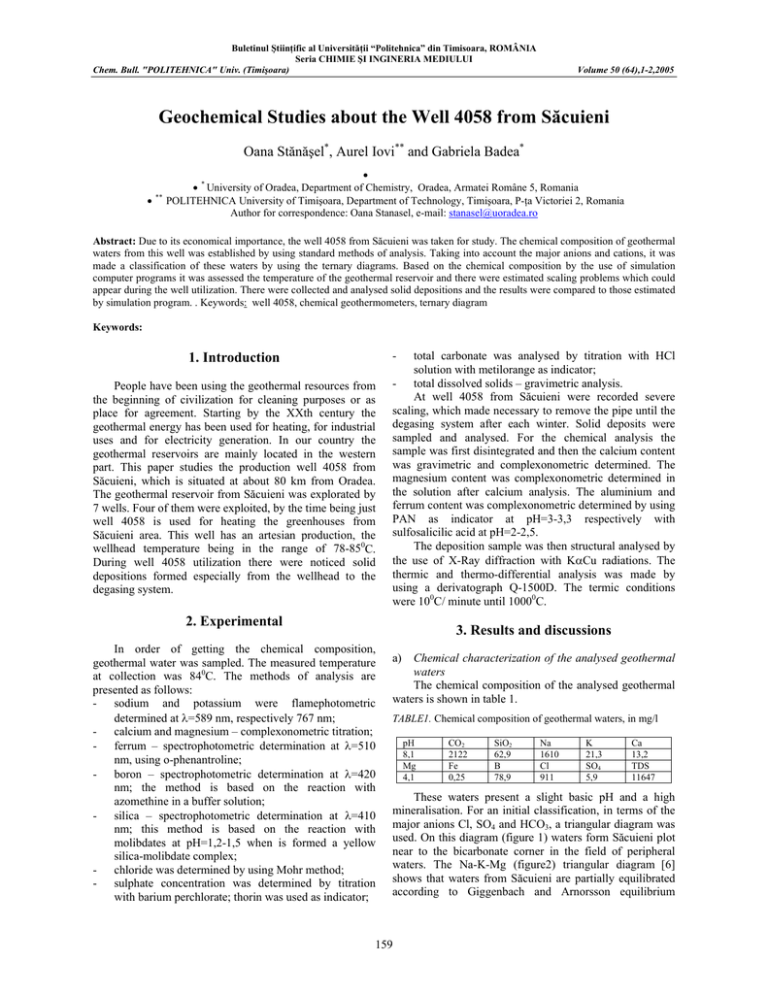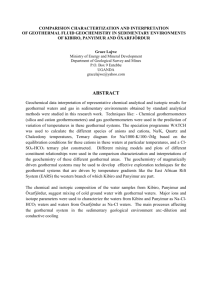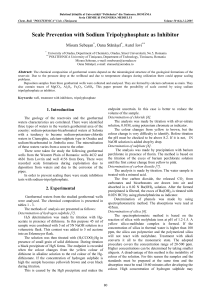Document 13359604
advertisement

Buletinul Ştiinţific al Universităţii “Politehnica” din Timisoara, ROMÂNIA Seria CHIMIE ŞI INGINERIA MEDIULUI Chem. Bull. "POLITEHNICA" Univ. (Timişoara) Volume 50 (64),1-2,2005 Geochemical Studies about the Well 4058 from Săcuieni Oana Stănăşel*, Aurel Iovi** and Gabriela Badea* • ** • • * University of Oradea, Department of Chemistry, Oradea, Armatei Române 5, Romania POLITEHNICA University of Timişoara, Department of Technology, Timişoara, P-ţa Victoriei 2, Romania Author for correspondence: Oana Stanasel, e-mail: stanasel@uoradea.ro Abstract: Due to its economical importance, the well 4058 from Săcuieni was taken for study. The chemical composition of geothermal waters from this well was established by using standard methods of analysis. Taking into account the major anions and cations, it was made a classification of these waters by using the ternary diagrams. Based on the chemical composition by the use of simulation computer programs it was assessed the temperature of the geothermal reservoir and there were estimated scaling problems which could appear during the well utilization. There were collected and analysed solid depositions and the results were compared to those estimated by simulation program. . Keywords: well 4058, chemical geothermometers, ternary diagram Keywords: - 1. Introduction People have been using the geothermal resources from the beginning of civilization for cleaning purposes or as place for agreement. Starting by the XXth century the geothermal energy has been used for heating, for industrial uses and for electricity generation. In our country the geothermal reservoirs are mainly located in the western part. This paper studies the production well 4058 from Săcuieni, which is situated at about 80 km from Oradea. The geothermal reservoir from Săcuieni was explorated by 7 wells. Four of them were exploited, by the time being just well 4058 is used for heating the greenhouses from Săcuieni area. This well has an artesian production, the wellhead temperature being in the range of 78-850C. During well 4058 utilization there were noticed solid depositions formed especially from the wellhead to the degasing system. total carbonate was analysed by titration with HCl solution with metilorange as indicator; - total dissolved solids – gravimetric analysis. At well 4058 from Săcuieni were recorded severe scaling, which made necessary to remove the pipe until the degasing system after each winter. Solid deposits were sampled and analysed. For the chemical analysis the sample was first disintegrated and then the calcium content was gravimetric and complexonometric determined. The magnesium content was complexonometric determined in the solution after calcium analysis. The aluminium and ferrum content was complexonometric determined by using PAN as indicator at pH=3-3,3 respectively with sulfosalicilic acid at pH=2-2,5. The deposition sample was then structural analysed by the use of X-Ray diffraction with KαCu radiations. The thermic and thermo-differential analysis was made by using a derivatograph Q-1500D. The termic conditions were 100C/ minute until 10000C. 2. Experimental 3. Results and discussions In order of getting the chemical composition, geothermal water was sampled. The measured temperature at collection was 840C. The methods of analysis are presented as follows: - sodium and potassium were flamephotometric determined at λ=589 nm, respectively 767 nm; - calcium and magnesium – complexonometric titration; - ferrum – spectrophotometric determination at λ=510 nm, using o-phenantroline; - boron – spectrophotometric determination at λ=420 nm; the method is based on the reaction with azomethine in a buffer solution; - silica – spectrophotometric determination at λ=410 nm; this method is based on the reaction with molibdates at pH=1,2-1,5 when is formed a yellow silica-molibdate complex; - chloride was determined by using Mohr method; - sulphate concentration was determined by titration with barium perchlorate; thorin was used as indicator; a) Chemical characterization of the analysed geothermal waters The chemical composition of the analysed geothermal waters is shown in table 1. TABLE1. Chemical composition of geothermal waters, in mg/l pH 8,1 Mg 4,1 CO2 2122 Fe 0,25 SiO2 62,9 B 78,9 Na 1610 Cl 911 K 21,3 SO4 5,9 Ca 13,2 TDS 11647 These waters present a slight basic pH and a high mineralisation. For an initial classification, in terms of the major anions Cl, SO4 and HCO3, a triangular diagram was used. On this diagram (figure 1) waters form Săcuieni plot near to the bicarbonate corner in the field of peripheral waters. The Na-K-Mg (figure2) triangular diagram [6] shows that waters from Săcuieni are partially equilibrated according to Giggenbach and Arnorsson equilibrium 159 Chem. Bull. "POLITEHNICA" Univ. (Timişoara) Volume 50 (64),1-2,2005 hot geothermal water with cold water. The intersection point with the solubility curve for chalcedony gives the enthalpy of the deep hot water component and its temperature is obtained from steam tables [7] (figure 3). 800 Cl 0 10 0 Sacuieni 4058 25 Steam loss Solubility of Quartz 400 75 . solubility of Chaledony solubility for quartz steam loss Cold water Geothermal water 600 SiO 2 (mg/kg) curves. This could be a good indicator that the chemical composition of these waters can be used for geothermometer calculations. b) Estimating the deep water temperature There were proposed several indicators to estimate the deep water temperature. The use of geothermometers is based on the supposition that there is an equilibrium between minerals from the rocks of the reservoir and the fluid from the reservoir. The chemical composition of the surface fluid is controlled as main by the composition of the minerals from the reservoir and the temperature. Solubility of Chalcedony 200 50 Vo lca Cl 0 s ter HCO3 400 800 1200 1600 2000 Enthalpy (kJ/kg) 25 wa SO4 75 0 ra l he rip Pe nic 50 wa ter s Mature waters Figure 3. Dissolved silica-enthalpy diagram 10 0 Steam heated waters 0 At Săcuieni, well 4058 this temperature calculated by mixing model is 1040C. The difference compared to the wellhead temperature is assumed to be due to mixing with cold water in the upper layers or due to contact by the cold rocks. 0 SO4 25 50 75 100 Figure 1. Cl-SO4-HCO3 ternary diagram HCO3 Na/1000 TABLE 2. Temperatures resulted by Watch program calculations 0 10 0 12 Well Săcuieni 4058 0 14 Sacuieni 4058 16 0 18 0 t kn T(chalcedony) 78,7 T(Na/K) 52,9 c) Scaling prediction and solid deposition analysis (°C) 200 22 0 Fully equilibrated waters by Giggenbach 240 260 Fully equilibrated waters by Arnorsson 280 300 320 340 Immature waters (°C) 100 km 120 t 140 160 180 200 220 240 260 30 0 340 K/100 T(quartz) 108,5 Mg Figure 2. Na-K-Mg equilibrium diagram Arnorsson and Fournier [5] concluded that the solubility of some components of the geothermal fluid is controlled by the temperature. The temperatures resulting from geothermometers which were calculated by the Watch program are presented in table 2. The reservoir temperature indicated by the calculated chalcedony geothermometer is closer to the production temperature of the water than the values given by the other geothermometers. Another way to estimate the reservoir temperature is by using the silica-enthalpy mixing model [1]. It is assumed that the surface geothermal water is the result of mixing of The composition and the mineralogical structure of the depositions depend on the chemical composition of geothermal waters, the temperature and the composition of the material of the distribution system. In this paper the Watch program [3] was used to predict possible scaling occuring during the utilization of geothermal well 4058. Based on the data regarding the solubility products when the equilibrated fluid is allowed to cool conductively from the reference temperature to some lower temperatures, the saturation indexes (log Q/K) were calculated. The scaling potential is estimated by calculating log Q/K for different minerals [8]. The mineral equilibrium diagram is presented in figure 4. From the figure 4 you can notice an undersaturation in respect with anhydrite, wollastonite, silica. The system is in equilibrium with calcedonia. Calcite is supersaturated both at the wellhead temperature and at lower temperatures which could be reached by utilization. The results of the chemical analysis [4] of the solid depositions formed during well 4058 utilization are presented in table 3. 160 Chem. Bull. "POLITEHNICA" Univ. (Timişoara) Volume 50 (64),1-2,2005 TABLE 3. Chemical composition of solid depositions, in % 5 CaO 53 4 MgO 1,5 Al2O3 0,8 Fe2O3 1,6 Calcinated losses 43 3 SACUIENI 4058 lo g Q /K 2 1 Anhydrite Chrysotile Calcite Wollastonite Sil.Amorph Chalcedony Quartz Talc 0 -1 -2 -3 -4 40 50 60 70 80 90 0 Temperature, C The data from table 3 shows that the main element of the deposition sample is calcium, that might be a calcium carbonate scale. The solid sample was then analysed by XRay diffraction [9], having information about the existence of calcite, magnesian crystals (figure 5). The diagram obtained by thermogravimetric analysis [2] (figure 6) indicates an endothermic effect, that starts at 6930C and reaches a maximum at 9500C. The mass loss represents 44%. This means that the sample consists of carbonates as main, the loss being carbon dioxide. This is similar with the loss obtained at chemical analysis. Figure 4. Log Q/K vs.temperature. Figure 5. The XRD diagram of the solid deposits. 161 Chem. Bull. "POLITEHNICA" Univ. (Timişoara) Volume 50 (64),1-2,2005 Figure 6. The thermo-differential diagram of the solid deposits. The calcite resulted from chemical analysis was predicted by the Watch program as well. 4. Conclusions The geothermal waters from Săcuieni, well 4058, by chemical composition are classified as bicarbonatedsodium-chloride waters. Considering the major anions the studied waters are classified as peripheral waters and taking into account the major cations the geothermal waters from Săcuieni are classified as partially equilibrated falling near to Giggenbach’s curve for fully equilibrated waters. The reservoir temperature calculated by silica-enthalpy mixing model is rather higher than the temperature given by the chalcedony geothermometer and the wellhead temperature, which indicates a mixing of hot water from the reservoir with the infiltrated cold water in the upper layers. Knowing the chemical composition, the scaling potential during well production could be estimate. In this way it is possible to interfere to prevent scale before it occurs. At well 4058, by Watch simulation program there were assessed calcium carbonate depositions at all the temperatures. The analysis of the solid samples indicated that the depositions consist of calcite and magnesian, CaCO3 being the main. The calcination loss is CO2, that confirms the presence of carbonates in the sample. References 1. Arnorsson, S.: J.Volc.Geotherm.Res., 1985, 23, 145. 2. Becherescu, D. et.al.: Metode fizice în chimia silicaţilor, Ed.St. şi Encicl. Bucureşti, 1977. 3. Bjarnason, J.O.: The speciation program Watch, version 2.1.Orkustofnun, Reykjavik, 1994. 4. Demetrescu, A.M., et.al.: Analiza tehnică a minereurilor, Ed.Tehn. Bucureşti, 1966. 5. Fournier, R.O.: Geothermics, 1977, 5, 49. 6. Giggenbach, W.F.: Geochim.Cosmochim.Acta, 1988, 52, 2749. 7. Keenan, J.H., et.al.: Steam Tables-Thermodynamic properties of water including vapor, liquid and solid phases, International Edition-metric units, Wiley, New York, 1969. 8. Mackenzie, W.S., Guilford, C.: Atlas of rock-forming minerals in thin section, Longman U.K., 1982. 9. Oana Stănăşel, Gilău, L., Ţarcă, A., Merca, V.: Scaling problems recorded at geothermal wells from Borş and Săcuieni, Romania, CD PROCEEDINGS, Twenty-Fifth Workshop on Geothermal Reservoir Engineering Stanford University, Stanford, California, January 24-26, 2000. 162








